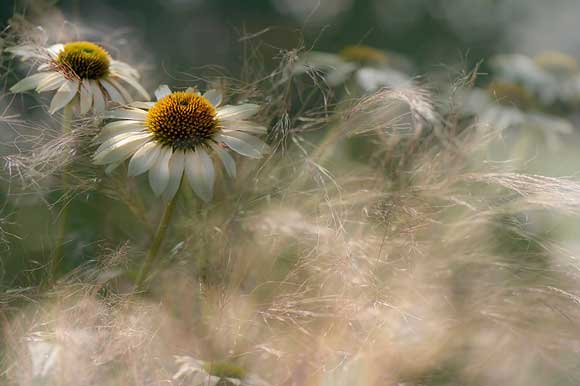Though a DSLR isn’t essential you’ll need a camera that gives you control over the depth of field (DoF). You’ll most likely be either working at small apertures for maximum depth of field, or wide ones to draw attention to a specific element using shallow depth of field. Many compacts have only two or three apertures to choose from and the small sensors make it hard to produce shallow DoF effects.
A macro lens, or a camera with macro capabilities, will increase your options by opening up the opportunity to shoot close-up detail shots of individual plants, or even single leaves or petals.
A telephoto lens, or tele-zoom will enable you to crop in tightly on interesting details – ensure these details aren’t close to the lens, though – and they also make it easier to produce shallow focus effects. Wideangle lenses are good for emphasing foreground elements in relation to the background, and, of course, getting more of the garden in shot.

First place, Garden Views: Marianne Majerus, International Garden Photographer of the Year 2010
Shafts of sunlight penetrate the morning mist in this beautifully lit image, which was the overall winner.
Leica R9, Fuji Velvia 50 film
Whether shooting entire gardens at smaller apertures, or single stems at close range, your chances of obtaining a sharp image will be dramatically increased if you use a tripod – first, to avoid camera shake, and second, to ensure that your narrow zone of focus falls in the right place.
A handheld reflector will block direct light, or fill in and soften shadows, making a huge difference to the lighting in your pictures. Folding ones are the most convenient to carry and use.
Flash is best avoided as it’s difficult to control, and produces hard shadows. A ringflash or macro light that fits around the lens can be useful for some types of close-up work, especially for insects, as they produce even, shadowless results, but take care to balance the exposure with the ambient light.
A polarising filter will reduce reflections on the surfaces of shiny leaves and petals, and boost colour saturation. It only works at certain angles to the direction of light, so it’s a case of trial and error, but in the right circumstances it has a dramatic effect on your pictures.

Highly commended, Plant Portraits:
Jacky Parker
The choice of slow shutter speed has motion-blurred the soft grasses as they swayed in the breeze, while the sturdier white coneflowers have remained sharp.
Nikon D200, Nikkor 105mm micro VR
Main Image (top) Finalist, Plant Portraits: Michael Lowe
Michael used a 180mm macro lens to isolate this section of a Japanese Hibiscus and create a pleasing composition.
Canon EOS 5D, 180mm Macro




